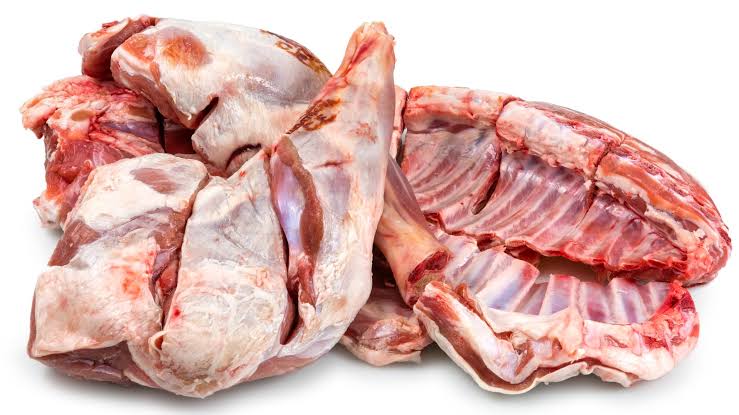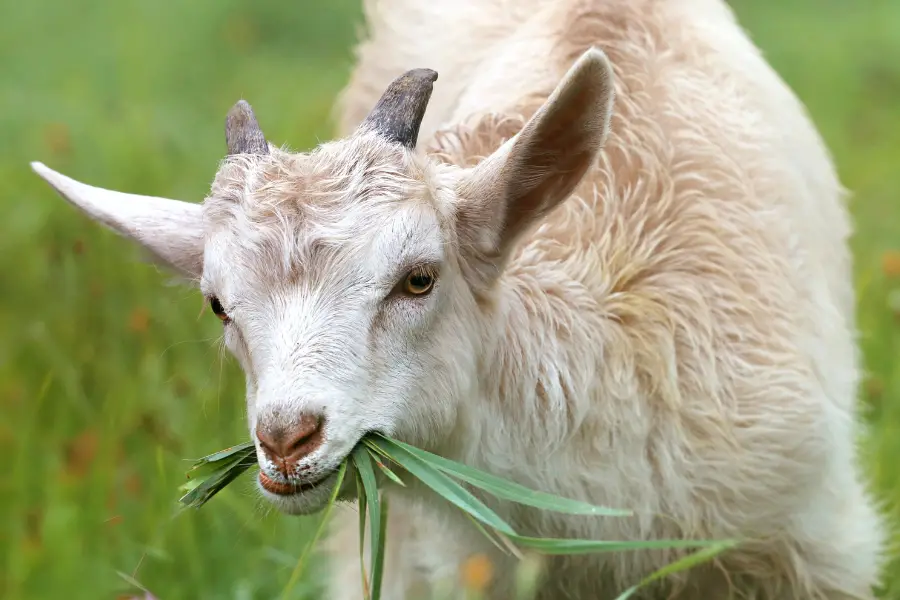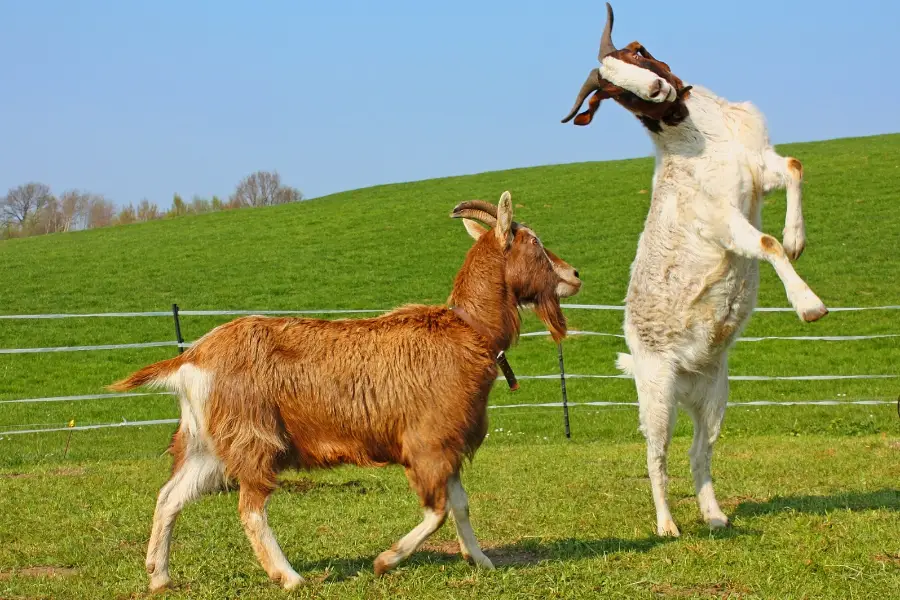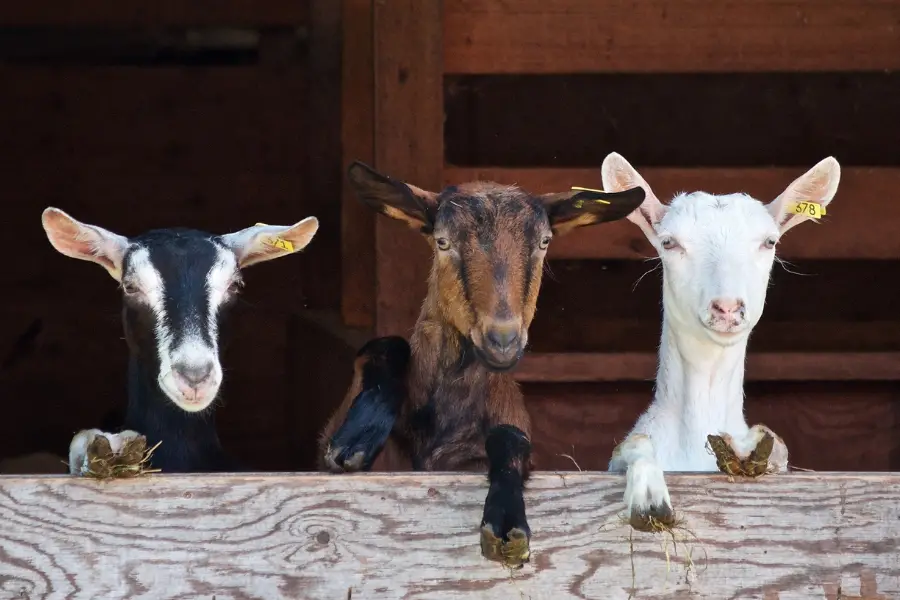
Savanna (also called “Savannah”) goats originated in South Africa in the 1950s, by breeding Boer goats with local landrace goats. In 1993, the Savanna Goat Society was created in South Africa, to recognize and perpetuate the breed, and within a year or two they were being imported to the United States.
The high litter weaning weight, easy breeding, and relatively low input of Savannas is the main reason for their economic value and popularity in the US.
Table of contents
Due to extensive crossbreeding, purebred Savanna goats are rare outside of South Africa, and conservationists recommend keeping conservation herds to preserve their status and explore desirable traits in the breed.
Savanna Goat Uses

Savanna goats were developed to be a low-input meat goat, able to adapt to rough climates and poor forage. They were also specifically developed for their rare white hair and dark skin. White goats are a particularly popular for meat in large parts of Africa, but most white goats have skin that is extremely sensitive to the sun and requires protection. The Savanna’s dark skin protects it from the sun and makes it easier to care for than other goats with white hair.
As meat goats, they are favored for having tender, flavorful meat and a balanced carcass with little fat.
Characteristics of Savanna Goats
Savanna goats are a hardy breed known for their adaptability to various climates and their excellent meat production. They possess unique characteristics that make them popular among farmers and breeders. In this article, we will explore the distinct features and qualities of Savanna goats.
Physical Attributes
Savanna goats are easily recognizable due to their distinct appearance. They have a well-muscled body with a sturdy frame, giving them an impressive stature. Here are some key physical attributes of Savanna goats:
- Color: These goats are predominantly white, although some may have pigmented skin around the eyes, nose, and ears. The white coat helps them reflect sunlight and cope with hot climates.
- Head: Savanna goats have a broad and strong head. They possess a prominent Roman nose, which is a slightly convex shape. The ears are medium-sized and upright.
- Horns: Both male and female Savanna goats usually have horns. The horns are strong, wide-set, and curve backward. They contribute to the breed’s distinctive appearance.
- Body: Savanna goats have a deep and wide chest, reflecting their high meat production capacity. The body is well-muscled with strong, straight legs, allowing for agile movement.
Adaptability
Savanna goats are renowned for their ability to adapt to different environments, making them suitable for various geographical regions. Here are some characteristics that contribute to their adaptability:
- Climate: Savanna goats are particularly well-suited to arid and semi-arid regions. They have a high tolerance for heat and can thrive in areas with limited water sources.
- Disease Resistance: These goats exhibit a remarkable resistance to diseases, including many common goat ailments. Their robust immune system reduces the need for frequent medical interventions.
- Foraging: Savanna goats are excellent foragers, capable of utilizing a wide range of vegetation for sustenance. They can browse on shrubs, weeds, and grasses, allowing them to thrive in diverse grazing conditions.
Meat Production
One of the primary reasons for the popularity of Savanna goats is their exceptional meat production qualities. Farmers and breeders appreciate the following characteristics related to meat production:
- Muscle Development: Savanna goats possess good muscling throughout their bodies, resulting in a higher meat-to-bone ratio. This attribute contributes to the breed’s reputation for producing quality meat.
- Fast Growth: These goats have a rapid growth rate, reaching market weight relatively quickly. Their ability to convert forage efficiently into muscle makes them an economically viable choice for meat production.
- Carcass Quality: Savanna goats produce carcasses with desirable traits such as tenderness, mild flavor, and minimal fat. The meat is well-marbled, ensuring a juicy and flavorful eating experience.
Temperament
Savanna goats are known for their calm and gentle nature. They exhibit the following temperament traits:
- Docility: Savanna goats have a friendly and approachable disposition, making them easy to handle and work with. This characteristic is advantageous for farmers during breeding, health checkups, and general management.
- Social Behavior: These goats are generally social animals, showing a preference for living in groups. They are adaptable to herd environments and display cooperative behavior within their social structure.
Savanna goats possess a range of characteristics that make them an attractive breed for farmers and breeders. Their physical attributes, adaptability to various climates, meat production capabilities, and calm temperament contribute to their popularity in the agricultural industry. Whether in challenging environments or meat production systems, Savanna goats continue to demonstrate their value as a versatile and valuable breed.
Raising Savanna Goats

Savanna goats were bred to be an independent, low-input breed. They are excellent foragers, and are able to grow rapidly with little supplemental food or nutrition. They are resistant to parasites, and tolerate heat and cold well. Females give birth in the open and are excellent mothers. Despite this independence and little need for human intervention, Savanna goats have a mellow temperament and are easier to handle than many other meat goat breeds.
Savanna Goat Shelter

Savanna goats are hardy and adaptable, and, once they are acclimated, they prefer to spend nights out in their pasture. However, they do require a shelter in rough weather. In mild climates, savanna goats can be perfectly happy in a sturdy, three-sided shelter with a packed earth floor and clean bedding.
Savanna Goat Fencing

Savanna goats are a large, active, robust breed. They need a sturdy fence, both to contain the goats and to exclude predators. Their fence should be at least 6 feet tall, with posts buried at least 2 feet or cement footing, and posts placed at 8 foot (or closer) intervals. If landscape features make it likely that goats will climb or jump the fence, an electric wire at the top and bottom will help to better contain these tough goats.
Breeding Savanna Goat

While Savanna goats are a meat goat, extensive crossbreeding in North America has made purebreds relatively scarce. This means that there may be more value in breeding Savanna goats than in growing them for meat.
Purebred Savanna goats may produce offspring that are not pure white, and thus don’t conform to the breed standard. However, such goats can still be registered as American Royal, a purebred Savanna in which color is deemed acceptable, as long as it conforms to all other Savanna standards.
Savanna Goats Price
Purebred Savanna goats are rare in the United States, and typically cost $750-$2,000, depending on the sex and the animal. Savanna/Boer crosses are much more common, and cost about half as much.
Choosing a Savanna Goat

It’s always important to choose the best goats for your stock, but it’s particularly important with a breed as rare and expensive as the Savanna goat.
Whenever possible, visit the breeder in person. A good breeder will welcome such a visit, since they care about the welfare of their goats, and want to check you out as well. On the farm, ask if you can have a look around. You should look at the goats’ pasture, shelter, and overall living environment, which should be relatively clean, well-kept, and healthy.
All their goats (and any other livestock, for that matter) should have good coats and good body weight, with no visibly ill or unhealthy animals. Get a good look at your goat’s parents, if possible. If a breeder won’t let you visit or look around, it’s cause to be suspicious.
If you can’t visit the farm in person, ask the breeder if they can give you contact information for other people who have purchased Savannas from them. The Savanna community is small, and people are usually eager to share their experiences, so it should not be a problem to contact other people who have bought goats from this particular breeder and ask about their goats’ health, habits, and disposition.
You can order whole herds of Savanna goats online from third party sellers like Amazon and Alibaba, but it’s a bad idea to take that risk and buy expensive goats from around the world sight unseen.
No matter where your Savanna comes from, here are the things to know and check before you buy:




